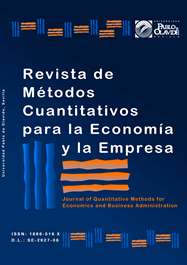Bank Restructuring: Analysis of Participating, Merged and Nationalized Entities
DOI:
https://doi.org/10.46661/revmetodoscuanteconempresa.2690Keywords:
fusiones, nacionalizadas, efectos marginales, Basilea III, mergers, nationalized, marginal effects, Basel IIIAbstract
In the nineties in the financial sector, there was an unprecedented process of mergers and acquisitions in Europe. This trend started in the United States in the eighties, quickly spreading to Europe. The study analyzes the variables that have a marginal effect on the probability by a financial institution to participate in a process of financial restructuring as a merged or nationalized entity. For this, categorical models with endogenous variable are used to represent the different situations of absorption being considered. In the modeling process we have used the usual econometric techniques for variable selection and their financial interpretability.
Downloads
References
Altunbas, Y.; Gardener, E. P. M.; Molyneux, P. y Moore , B. (2001): Efficiency in European Banking. European Economic Review, 45:10, pp. 1931–1955.
Basel Committee on Banking Supervision (2010): Basel III: A global regulatory framework for more resilient banks and banking systems. Disponible en http://www.bis.org/publ/bcbs189.pdf.
Berger, A. N.; Hanweck, G. y Humphrey, D. B. (1987): Competitive Viability in Banking, Scale, Scope, and Product Mix Economies. Journal of Monetary Economics, 20, pp. 501–520.
Berger, P. G. y Ofek, E. (1995): Diversification’s Effect on Firm Value. Journal of Financial Economics, 37:1, pp. 39–65.
Carbó, S. y Humphrey, D. B. (2004): Predicted and Actual Costs from Individual Bank Mergers. Journal of Economics and Business, 56:2, pp. 137–157.
Cavallo, L. y Rossi, S. P. S. (2001): Scale and Scope Economies in the European Banking Systems. Journal of Multinational Financial Management, 11, pp. 515–531.
Cyree, K. B.; Wansley, J. W. y Black, H. A. (2000): Determinants of Bank Growth Choices. Journal of Banking and Finance, 24, pp. 709–734.
Comité de Supervisión Bancaria de Basilea, Comunicado de prensa (2010): El Grupo de Gobernadores y Jefes de Supervisión alcanzan un amplio en torno al paquete de reformas del Comité de Basilea sobre el capital y liquidez. Disponible en http://www.bis.org/press/p100912_es.pdf.
Fanjul, O. y Maraval, F. (1985): La eficiencia del sistema bancario español. Alianza, Madrid.
Fernández, M. (2011): La reestructuración del sector bancario español y el Real Decreto–ley para el reforzamiento del sistema. Banco de España, Eurosistema. Disponible en http://www.bde.es/webbde/es/secciones/prensa/intervenpub/gobernador/mfo210211.pdf.
Maudos, J.; Pastor, J. M.; Pérez, F. y Quesada, J. (2002): Cost and Profit Efficiency in European Banks. Journal of International Financial Markets, Institutions and Money, 12:1, pp. 33–58.
McAllister, P. H. y McManus, D. (1993): Resolving the Scale Efficiency Puzzle in Banking. Journal of Banking and Finance, 17:2–3, pp. 389–405.
Ministerio de Asuntos Exteriores y de Cooperación (2012): Memorando de entendimiento sobre condiciones de política sectorial financiera. Disponible en https://www.boe.es/boe/dias/2012/12/10/pdfs/BOE-A-2012-14946.pdf.
Mitchell, M. L. y Mulherin, J. H. (1996): The Impact of Industry Shocks on Takeover and Restructuring Activity. Journal of Financial Economics, 41:2, pp. 193–229.
Real Decreto–ley 9/2009, de 26 de junio, sobre reestructuración bancaria y reforzamiento de los recursos propios de las entidades de crédito. Disponible en http://www.boe.es/boe/dias/2009/06/27/pdfs/BOE-A-2009-10575.pdf.
Real Decreto–ley 11/2010, de 9 de julio, de órganos de gobierno y otros aspectos del régimen jurídico de las Cajas de Ahorros. Disponible en https://www.boe.es/boe/dias/2010/07/13/pdfs/BOE-A-2010-11086.pdf.
Real Decreto–ley 6/2010, de 9 de abril, de medidas para el impulso de la recuperación económica y el empleo. Disponible en https://www.boe.es/boe/dias/2010/04/13/pdfs/BOE-A-2010-5879.pdf.
Real Decreto–ley 2/2011, de 18 de febrero, para el reforzamiento financiero. Disponible en http://www.boe.es/boe/dias/2011/02/19/pdfs/BOE-A-2011-3254. pdf.
Real Decreto–ley 16/2011, de 14 de octubre, por el que se crea el Fondo de Garantía de Depósitos de Entidades de Crédito. Disponible en www.boe.es/boe/dias/2011/10/15/pdfs/BOE–A–2011–16173.pdf.
Real Decreto–ley 2/2012, de 3 de febrero, de saneamiento del sector financiero. Disponible en www.boe.es/boe/dias/2012/02/04/pdfs/BOE–A–2012–1674.pdf.
Real Decreto–ley 24/2012, de 31 de agosto, de reestructuración y resolución de entidades de crédito. Disponible en http://www.boe.es/boe/dias/2012/08/31/pdfs/BOE–A–2012–11247.pdf.
FROB Fondo de Reestructuración Ordenada Bancaria (2012): Reestructuración y Recapitalización del Sector Bancario: la Sociedad de Gestión de Activos (Sareb). Disponible en http://www.frob.es/es/Lists/Contenidos/Attachments/342/20121029_Presentacion_FROB_SGA_es_%20prot.pdf.
Banco de España (2012): Resultados de la evaluación independiente del sector bancario español. Disponible en http://www.bde.es/f/webbde/SSICOM/20120928presentacion2809 12.pdf.
Sutton, C. J. (1980): Economics and Corporate Strategy. Cambridge University Press, Nueva York.
Thompson, S. (1997): Takeover Activity Among Financial Mutuals: An Analysis of Target Characteristics. Journal of Banking and Finance, 21:1, pp. 37–53.
Vander Vennet, R. (1999): Causes and Consequences of EU Bank Takeovers. En Eijffinger, S.; Koedijk, K.; Pagano, M. y Portes, R. (eds.): The Changing European Financial Landscape, London: CEPR, pp. 45-61.
Vives, X. (1988): Concentración bancaria y competitividad. Papeles de Economía Española, 36, pp. 62–75.
Wheelock, D. C. y Wilson, P. W. (2001): New Evidence on Returns to Scale and Product Mix Among US Commercial Banks. Journal of Monetary Economics, 47:3, pp. 653–674.
Worthington, A. C. (2004): Determinants of Merger and Acquisition Activity in Australian Cooperative Deposit– Taking Institutions. Journal of Business Research, 57:1, pp. 47–57.
Downloads
Published
How to Cite
Issue
Section
License
Copyright (c) 2017 Journal of Quantitative Methods for Economics and Business Administration

This work is licensed under a Creative Commons Attribution-ShareAlike 4.0 International License.
Submission of manuscripts implies that the work described has not been published before (except in the form of an abstract or as part of thesis), that it is not under consideration for publication elsewhere and that, in case of acceptance, the authors agree to automatic transfer of the copyright to the Journal for its publication and dissemination. Authors retain the authors' right to use and share the article according to a personal or instutional use or scholarly sharing purposes; in addition, they retain patent, trademark and other intellectual property rights (including research data).
All the articles are published in the Journal under the Creative Commons license CC-BY-SA (Attribution-ShareAlike). It is allowed a commercial use of the work (always including the author attribution) and other derivative works, which must be released under the same license as the original work.
Up to Volume 21, this Journal has been licensing the articles under the Creative Commons license CC-BY-SA 3.0 ES. Starting from Volume 22, the Creative Commons license CC-BY-SA 4.0 is used.










